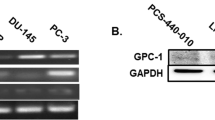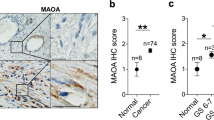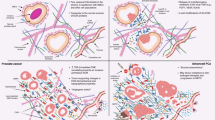Abstract
SPARC (Secreted Protein Acidic and Rich in Cysteine), is a matricellular glycoprotein that is produced by tumor and/or neighboring stroma. In human prostate cancer, SPARC immunoreactivity is highest in metastatic lesions but distinct contributions of tumoral and stromal SPARC to tumorigenesis and progression are unclear. To determine the role of SPARC in primary prostate tumorigenesis, we crossed SPARC-null (SP−/−) with TRAMP (Transgenic Adenocarcinoma of Mouse Prostate) mice. TRAMP+/SP−/− mice exhibited accelerated cancer development and progression. Compared to their TRAMP+/SP−/− counterparts, TRAMP+/SP+/+ tumors had fewer proliferating cells, and decreased cyclins A and D1 with increased p21Cip and p27Kip. Similar effects on proliferation and cell-cycle regulators were observed in human prostate cancer cell lines, transiently transfected with pSPARC. TRAMP+/SP−/− tumors exhibited decreased stromal collagen, enhanced matrix metalloproteinase activity and increased vascular endothelial growth factor, proinflammatory cytokines. To determine the contribution of stromal SPARC, we evaluated subcutaneous tumor growth of TRAMP cell lines in syngeneic SP+/+ and SP−/− mice. Enhanced growth, decreased stromal collagen and increased proteolysis were noted in SP−/− mice. Our findings demonstrate that both tumor and stromal SPARC are limiting for primary prostate tumorigenesis and progression, through effects on the cell cycle and the creation of a less favorable tumor microenvironment.
This is a preview of subscription content, access via your institution
Access options
Subscribe to this journal
Receive 50 print issues and online access
$259.00 per year
only $5.18 per issue
Buy this article
- Purchase on Springer Link
- Instant access to full article PDF
Prices may be subject to local taxes which are calculated during checkout






Similar content being viewed by others
References
Aycock RL, Bradshaw AC, Sage EH, Starcher B . (2004). Development of UV-induced squamous cell carcinomas is suppressed in the absence of SPARC. J Invest Dermatol 123: 592–599.
Basu A, Rodeck U, Prendergast GC, Howe CC . (1999). Loss of insulin-like growth factor I receptor-dependent expression of p107 and cyclin A in cells that lack the extracellular matrix protein secreted protein acidic and rich in cysteine. Cell Growth Differ 10: 721–728.
Bennett WP, el-Deiry WS, Rush WL, Guinee Jr DG, Freedman AN, Caporaso NE et al. (1998). p21waf1/cip1 and transforming growth factor beta 1 protein expression correlate with survival in non-small cell lung cancer. Clin Cancer Res 4: 1499–1506.
Bradshaw AD, Francki A, Motamed K, Howe C, Sage EH . (1999). Primary mesenchymal cells isolated from SPARC-null mice exhibit altered morphology and rates of proliferation. Mol Biol Cell 10: 1569–1579.
Brekken RA, Puolakkainen P, Graves DC, Workman G, Lubkin SR, Sage EH . (2003). Enhanced growth of tumors in SPARC null mice is associated with changes in the ECM. J Clin Invest 111: 487–495.
Buijs JT, Henriquez NV, van Overveld PG, van der Horst G, ten Dijke P, van der Pluijm G . (2007). TGF-beta and BMP7 interactions in tumour progression and bone metastasis. Clin Exp Metastasis 24: 609–617.
Bussard KM, Gay CV, Mastro AM . (2008). The bone microenvironment in metastasis; what is special about bone? Cancer Metastasis Rev 27: 41–55.
Cheetham S, Tang MJ, Mesak F, Kennecke H, Owen D, Tai IT . (2008). SPARC promoter hypermethylation in colorectal cancers can be reversed by 5-Aza-2′deoxycytidine to increase SPARC expression and improve therapy response. Br J Cancer 98: 1810–1819.
Chen N, Ye XC, Chu K, Navone NM, Sage EH, Yu-Lee LY et al. (2007). A secreted isoform of ErbB3 promotes osteonectin expression in bone and enhances the invasiveness of prostate cancer cells. Cancer Res 67: 6544–6548.
Chin D, Boyle GM, Williams RM, Ferguson K, Pandeya N, Pedley J et al. (2005). Novel markers for poor prognosis in head and neck cancer. Int J Cancer 113: 789–797.
Chlenski A, Guerrero LJ, Yang Q, Tian Y, Peddinti R, Salwen HR et al. (2007). SPARC enhances tumor stroma formation and prevents fibroblast activation. Oncogene 26: 4513–4522.
Chlenski A, Liu S, Guerrero LJ, Yang Q, Tian Y, Salwen HR et al. (2006). SPARC expression is associated with impaired tumor growth, inhibited angiogenesis and changes in the extracellular matrix. Int J Cancer 118: 310–316.
Comstock CE, Revelo MP, Buncher CR, Knudsen KE . (2007). Impact of differential cyclin D1 expression and localisation in prostate cancer. Br J Cancer 96: 970–979.
De S, Chen J, Narizhneva NV, Heston W, Brainard J, Sage EH et al. (2003). Molecular pathway for cancer metastasis to bone. J Biol Chem 278: 39044–39050.
Dhanasekaran SM, Barrette TR, Ghosh D, Shah R, Varambally S, Kurachi K et al. (2001). Delineation of prognostic biomarkers in prostate cancer. Nature 412: 822–826.
Francki A, Motamed K, McClure TD, Kaya M, Murri C, Blake DJ et al. (2003). SPARC regulates cell cycle progression in mesangial cells via its inhibition of IGF-dependent signaling. J Cell Biochem 88: 802–811.
Gilmour DT, Lyon GJ, Carlton MB, Sanes JR, Cunningham JM, Anderson JR et al. (1998). Mice deficient for the secreted glycoprotein SPARC/osteonectin/BM40 develop normally but show severe age-onset cataract formation and disruption of the lens. EMBO J 17: 1860–1870.
Gingrich JR, Barrios RJ, Morton RA, Boyce BF, DeMayo FJ, Finegold MJ et al. (1996). Metastatic prostate cancer in a transgenic mouse. Cancer Res 56: 4096–4102.
Greenberg NM, DeMayo F, Finegold MJ, Medina D, Tilley WD, Aspinall JO et al. (1995). Prostate cancer in a transgenic mouse. Proc Natl Acad Sci USA 92: 3439–3443.
Jacob K, Webber M, Benayahu D, Kleinman HK . (1999). Osteonectin promotes prostate cancer cell migration and invasion: a possible mechanism for metastasis to bone. Cancer Res 59: 4453–4457.
Jemal A, Siegel R, Ward E, Hao Y, Xu J, Murray T et al. (2008). Cancer statistics, 2008. CA Cancer J Clin 58: 71–96.
Kahn SL, Ronnett BM, Gravitt PE, Gustafson KS . (2008). Quantitative methylation-specific PCR for the detection of aberrant DNA methylation in liquid-based Pap tests. Cancer 114: 57–64.
Kaplan-Lefko PJ, Chen TM, Ittmann MM, Barrios RJ, Ayala GE, Huss WJ et al. (2003). Pathobiology of autochthonous prostate cancer in a pre-clinical transgenic mouse model. Prostate 55: 219–237.
Kato Y, Nagashima Y, Baba Y, Kawano T, Furukawa M, Kubota A et al. (2005). Expression of SPARC in tongue carcinoma of stage II is associated with poor prognosis: an immunohistochemical study of 86 cases. Int J Mol Med 16: 263–268.
Kelloff GJ, Lippman SM, Dannenberg AJ, Sigman CC, Pearce HL, Reid BJ et al. (2006). Progress in chemoprevention drug development: the promise of molecular biomarkers for prevention of intraepithelial neoplasia and cancer—a plan to move forward. Clin Cancer Res 12: 3661–3697.
Kingsley LA, Fournier PG, Chirgwin JM, Guise TA . (2007). Molecular biology of bone metastasis. Mol Cancer Ther 6: 2609–2617.
Koblinski JE, Kaplan-Singer BR, VanOsdol SJ, Wu M, Engbring JA, Wang S et al. (2005). Endogenous osteonectin/SPARC/BM-40 expression inhibits MDA-MB-231 breast cancer cell metastasis. Cancer Res 65: 7370–7377.
Koukourakis MI, Giatromanolaki A, Brekken RA, Sivridis E, Gatter KC, Harris AL et al. (2003). Enhanced expression of SPARC/osteonectin in the tumor-associated stroma of non-small cell lung cancer is correlated with markers of hypoxia/acidity and with poor prognosis of patients. Cancer Res 63: 5376–5380.
Lapointe J, Li C, Higgins JP, van de Rijn M, Bair E, Montgomery K et al. (2004). Gene expression profiling identifies clinically relevant subtypes of prostate cancer. Proc Natl Acad Sci USA 101: 811–816.
Ledda F, Bravo AI, Adris S, Bover L, Mordoh J, Podhajcer OL . (1997). The expression of the secreted protein acidic and rich in cysteine (SPARC) is associated with the neoplastic progression of human melanoma. J Invest Dermatol 108: 210–214.
Maitland N . (2008). The search for genes which influence prostate cancer metastasis. In: Ablin RJ, Mason MD (eds). Metastasis of Prostate Cancer. Springer: Dordrecht. pp 21–61.
Motamed K, Funk SE, Koyama H, Ross R, Raines EW, Sage EH . (2002). Inhibition of PDGF-stimulated and matrix-mediated proliferation of human vascular smooth muscle cells by SPARC is independent of changes in cell shape or cyclin-dependent kinase inhibitors. J Cell Biochem 84: 759–771.
Pan MR, Chang HC, Chuang LY, Hung WC . (2008). The nonsteroidal anti-inflammatory drug NS398 reactivates SPARC expression via promoter demethylation to attenuate invasiveness of lung cancer cells. Exp Biol Med (Maywood) 233: 456–462.
Pienta KJ, Abate-Shen C, Agus DB, Attar RM, Chung LW, Greenberg NM et al. (2008). The current state of preclinical prostate cancer animal models. Prostate 68: 629–639.
Podhajcer OL, Benedetti L, Girotti MR, Prada F, Salvatierra E, Llera AS . (2008). The role of the matricellular protein SPARC in the dynamic interaction between the tumor and the host. Cancer Metastasis Rev 27: 523–537.
Puolakkainen PA, Brekken RA, Muneer S, Sage EH . (2004). Enhanced growth of pancreatic tumors in SPARC-null mice is associated with decreased deposition of extracellular matrix and reduced tumor cell apoptosis. Mol Cancer Res 2: 215–224.
Rodriguez-Jimenez FJ, Caldes T, Iniesta P, Vidart JA, Garcia-Asenjo JL, Benito M . (2007). Overexpression of SPARC protein contrasts with its transcriptional silencing by aberrant hypermethylation of SPARC CpG-rich region in endometrial carcinoma. Oncol Rep 17: 1301–1307.
Roy S, Kaur M, Agarwal C, Tecklenburg M, Sclafani RA, Agarwal R . (2007). p21 and p27 induction by silibinin is essential for its cell cycle arrest effect in prostate carcinoma cells. Mol Cancer Ther 6: 2696–2707.
Sage H, Decker J, Funk S, Chow M . (1989). SPARC: a Ca2+-binding extracellular protein associated with endothelial cell injury and proliferation. J Mol Cell Cardiol 21 (Suppl 1): 13–22.
Said N, Motamed K . (2005). Absence of host-secreted protein acidic and rich in cysteine (SPARC) augments peritoneal ovarian carcinomatosis. Am J Pathol 167: 1739–1752.
Said N, Najwer I, Motamed K . (2007a). Secreted protein acidic and rich in cysteine (SPARC) inhibits integrin-mediated adhesion and growth factor-dependent survival signaling in ovarian cancer. Am J Pathol 170: 1054–1063.
Said N, Socha MJ, Olearczyk JJ, Elmarakby AA, Imig JD, Motamed K . (2007b). Normalization of the ovarian cancer microenvironment by SPARC. Mol Cancer Res 5: 1015–1030.
Said NA, Najwer I, Socha MJ, Fulton DJ, Mok SC, Motamed K . (2007c). SPARC inhibits LPA-mediated mesothelial-ovarian cancer cell crosstalk. Neoplasia 9: 23–35.
Sangaletti S, Stoppacciaro A, Guiducci C, Torrisi MR, Colombo MP . (2003). Leukocyte, rather than tumor-produced SPARC, determines stroma and collagen type IV deposition in mammary carcinoma. J Exp Med 198: 1475–1485.
Sansom OJ, Mansergh FC, Evans MJ, Wilkins JA, Clarke AR . (2007). Deficiency of SPARC suppresses intestinal tumorigenesis in APCMin/+ mice. Gut 56: 1410–1414.
Sato N, Fukushima N, Maehara N, Matsubayashi H, Koopmann J, Su GH et al. (2003). SPARC/osteonectin is a frequent target for aberrant methylation in pancreatic adenocarcinoma and a mediator of tumor-stromal interactions. Oncogene 22: 5021–5030.
Schultz C, Lemke N, Ge S, Golembieski WA, Rempel SA . (2002). Secreted protein acidic and rich in cysteine promotes glioma invasion and delays tumor growth in vivo. Cancer Res 62: 6270–6277.
Seraj MJ, Thomas AR, Chin JL, Theodorescu D . (2001). Molecular determination of perivesical and lymph node metastasis after radical cystectomy for urothelial carcinoma of the bladder. Clin Cancer Res 7: 1516–1522.
Socha MJ, Said N, Dai Y, Kwong J, Ramalingam P, Trieu V et al. (2009). Aberrant promoter methylation of sparc in ovarian cancer. Neoplasia 11: 126–135.
Sova P, Feng Q, Geiss G, Wood T, Strauss R, Rudolf V et al. (2006). Discovery of novel methylation biomarkers in cervical carcinoma by global demethylation and microarray analysis. Cancer Epidemiol Biomarkers Prev 15: 114–123.
Sugimura Y, Cunha GR, Donjacour AA . (1986). Morphogenesis of ductal networks in the mouse prostate. Biol Reprod 34: 961–971.
Suzuki M, Hao C, Takahashi T, Shigematsu H, Shivapurkar N, Sathyanarayana UG et al. (2005). Aberrant methylation of SPARC in human lung cancers. Br J Cancer 92: 942–948.
Tai IT, Dai M, Owen DA, Chen LB . (2005). Genome-wide expression analysis of therapy-resistant tumors reveals SPARC as a novel target for cancer therapy. J Clin Invest 115: 1492–1502.
Thomas R, True LD, Bassuk JA, Lange PH, Vessella RL . (2000). Differential expression of osteonectin/SPARC during human prostate cancer progression. Clin Cancer Res 6: 1140–1149.
Tomlins SA, Mehra R, Rhodes DR, Cao X, Wang L, Dhanasekaran SM et al. (2007). Integrative molecular concept modeling of prostate cancer progression. Nat Genet 39: 41–51.
Wang Y, Yu Q, Cho AH, Rondeau G, Welsh J, Adamson E et al. (2005). Survey of differentially methylated promoters in prostate cancer cell lines. Neoplasia 7: 748–760.
Wong SY, Crowley D, Bronson RT, Hynes RO . (2008). Analyses of the role of endogenous SPARC in mouse models of prostate and breast cancer. Clin Exp Metastasis 25: 109–118.
Woodward JK, Holen I, Coleman RE, Buttle DJ . (2007). The roles of proteolytic enzymes in the development of tumour-induced bone disease in breast and prostate cancer. Bone 41: 912–927.
Yamashita K, Upadhay S, Mimori K, Inoue H, Mori M . (2003). Clinical significance of secreted protein acidic and rich in cystein in esophageal carcinoma and its relation to carcinoma progression. Cancer 97: 2412–2419.
Yang E, Kang HJ, Koh KH, Rhee H, Kim NK, Kim H . (2007). Frequent inactivation of SPARC by promoter hypermethylation in colon cancers. Int J Cancer 121: 567–575.
Acknowledgements
This work was supported by NIH CA104106 (DT) and Georgia Cancer Coalition grant GCC0023 (KM) and the National Institutes of Health grants K01-CA089689 (KM).
Author information
Authors and Affiliations
Corresponding author
Additional information
Supplementary Information accompanies the paper on the Oncogene website (http://www.nature.com/onc)
Rights and permissions
About this article
Cite this article
Said, N., Frierson, H., Chernauskas, D. et al. The role of SPARC in the TRAMP model of prostate carcinogenesis and progression. Oncogene 28, 3487–3498 (2009). https://doi.org/10.1038/onc.2009.205
Received:
Revised:
Accepted:
Published:
Issue Date:
DOI: https://doi.org/10.1038/onc.2009.205
Keywords
This article is cited by
-
Exercise in advanced prostate cancer elevates myokine levels and suppresses in-vitro cell growth
Prostate Cancer and Prostatic Diseases (2022)
-
Exercise-induced myokines and their effect on prostate cancer
Nature Reviews Urology (2021)
-
Re-sensitization of 5-FU resistance by SPARC through negative regulation of glucose metabolism in hepatocellular carcinoma
Tumor Biology (2015)
-
SPARC mediates metastatic cooperation between CSC and non-CSC prostate cancer cell subpopulations
Molecular Cancer (2014)
-
Stromal expression of SPARC in pancreatic adenocarcinoma
Cancer and Metastasis Reviews (2013)



